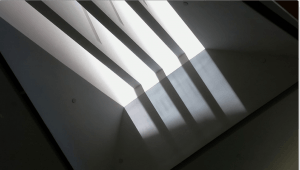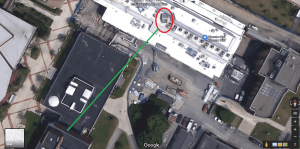A few weeks ago I visited Wooster Hall with a time-lapse camera to try to see what happens to the light from the skylight over the main staircase at solar noon on the Winter Solstice. I was a few days early, but even so, I think I uncovered the basic idea, which you can review in a previous blog post.
The result is that the four columns of light that appear at the bottom of the staircase on the equinoxes now appear on the slanted ceiling near the skylight, and don’t extend down any further. Here’s a picture (click on it for a bigger view):

But as you will notice, there appears to be something in the way, preventing the columns of light from extending all the way downward, especially on the left. What could that be? In the original post of the video I mused that perhaps there is something on the roof which is casting a shadow. Looking at the roof from a nearby building I could see that there are vents on the roof that are near that skylight. And after that post I heard from the building architect that those vents are necessary to remove smoke in the event of a fire. It’s doubtful they could be moved. But from that viewpoint I wasn’t sure that these were actually in line with the skylight, and I’m still doubtful that they are the culprit.
Someone else suggested that I could see what is on the roof using Google Maps. That turned out to be very helpful. Here’s the view from directly above, with some added markings (click on the image for a bigger view):

The skylight is circled in red, and the green line shows my line of sight from the Chemistry building to the Wooster roof. As indicated by the compass needle at the right edge, vertical on this photo is North, and as you might expect the four openings in the skylight line up with North, rather than with the building. You can also see the vents near the skylight, the sort-of round things that are to the right and below the skylight. But note that they are NOT directly below (i.e. South of) the skylight. This means that they cannot be blocking the light in the way seen in the videos! Which is what I suspected when viewing them from the Chemistry building.
So what is blocking the light? I’m going to guess that it’s the roof itself — actually a wall which is a part of the roof. As you can see from the photo, the roof has several levels (it’s easier to see this from the side view from the other building). The part of the roof where the skylight is located is higher than the roof farther to the south, and there is a wall dividing the two levels. You can see this a little better if we zoom in (again, click on the picture to make it (somewhat) larger):

The orange line shows the position of the wall, which I suspect is just high enough to block the lower part of the skylight when the sun is at its lowest in the sky, on the Winter Solstice. If you go back to the picture of the skylight from the inside, it looks like whatever is casting the shadow is larger on the left and sloping down to the right. But keep in mind that the building is turned away from North, and the skylight image is cast on a slanted ceiling/wall (which might even be curved). My guess is that the shadow is actually a horizontal line, caused by the wall on the roof.
And, by the way, if you don’t see that the orange line marks the position of a wall, then go to Google Maps yourself and find this building and select the “satellite” view. The way Google presents the images they actually change your view slightly as you drag the map, giving a sense of 3D which shows more clearly that the roof has multiple levels. It’s pretty cool that they can do this without your having to wear 3D glasses.
Is there anything we can do to unblock the sun? Well, at least it’s not a vent that’s required for fire safety, but the wall is probably necessary too. Maybe a section of the wall could be replaced with an open railing or chain-link fence which would still provide safety to whoever is working up there, but would let the light through to the entire skylight at the Winter Solstice. Or maybe not.
I still want to get up on the roof to try to confirm this conjecture. By measuring the distance of the bottom of the skylight to the base of the wall, along with the height of the wall, I could determine the position of the shadow of the wall for a given elevation of the sun, and verify that the shadow would reach the skylight. And maybe figure out how much the wall would have to be lowered (instead of completely removed). This isn’t over yet, so stay tuned…